The Christmas Album
- moira finnie
- Administrator
- Posts: 8024
- Joined: April 9th, 2007, 6:34 pm
- Location: Earth
- Contact:
-
klondike
Hey, I never said I didn't like Lew Ayres (even though he did betray Lorne Greene to the Cylonsmoirafinnie wrote:
Lots of people like Lew Ayres, Klon. Even me.
That's also akin to my real-world beef with Janey W; I could have been a pretty decent fan of hers if she'd been cast as a character actor, a la Arden, or Greenwood; but darn it, they kept tossing her up there as a central character, or a romantic lead, or as the other woman, or the dreamy-eyed wannabe, and with the looks that she'd been blessed with, I just could never appreciate her in those roles.
And, seriously, M, thanks for those insightful thoughts on both of these performers!
Klondike:
I'm with knitwit trying to figure why we all love you!
As for Jane, I still contend her whole problem is her hair. Look her up on imdB and see the photo they use of her - - - she's darling. Or next time Night and Day is on, check her out, again she is cute as a puppy. She logged onto that hairdo some time in the late 40's and kept with it until she died - she even kept those horrible bangs and covered ears in Cheyenne, one of her few westerns. I guess she was like Dietriech and Crawford who both looked good as youngsters, but aged long before their time, although her face didn't age, the hair made her look off beat.
Anne
I'm with knitwit trying to figure why we all love you!
As for Jane, I still contend her whole problem is her hair. Look her up on imdB and see the photo they use of her - - - she's darling. Or next time Night and Day is on, check her out, again she is cute as a puppy. She logged onto that hairdo some time in the late 40's and kept with it until she died - she even kept those horrible bangs and covered ears in Cheyenne, one of her few westerns. I guess she was like Dietriech and Crawford who both looked good as youngsters, but aged long before their time, although her face didn't age, the hair made her look off beat.
Anne
Anne
***********************************************************************
* * * * * * * * What is past is prologue. * * * * * * * *
]***********************************************************************
***********************************************************************
* * * * * * * * What is past is prologue. * * * * * * * *
]***********************************************************************
-
klondike
Wow!moirafinnie wrote:Hey Klon & Judith,
You'll probably be really happy to know that according to Marc Eliot's new bio Reagan in Hollywood, Ronnie drove Jane nuts by constantly calling her "button nose"--affectionately, of course. Eliot almost implies that it may have contributed to their divorce.
Good thing RR never took up with a Mediterranean looking chick, like Ina Balin, or Anna Magnani, or Irene Pappas; he probably would've dubbed her "hook & eye"!
Ah well, I guess it's all in what the beholder beholds; for my two cents, if Ms. Wyman's face centered around a button, I'd rather she'd sported a zipper!
- moira finnie
- Administrator
- Posts: 8024
- Joined: April 9th, 2007, 6:34 pm
- Location: Earth
- Contact:
The Christmas Album: Peggy
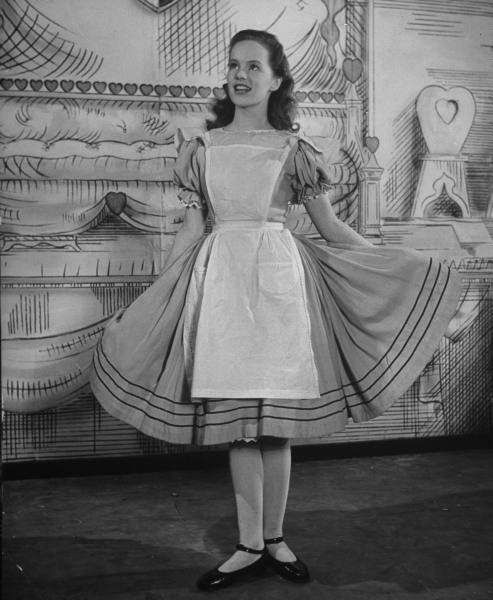
The Twenty-Third day of our Holiday outing finds us enjoying a "panto"--(pantomime to Americans) at this time of year very popular theatrical set-pieces with all sorts of magical, rude, and funny stories enacted by some of the best of British theater--here we see Welsh born Peggy Cummins as Alice in Wonderland in a Christmastime, 1945 stage production of Lewis Carroll's evergreen exploration of all things seen through the looking glass. Perhaps this role prepared Ms. Cummins for her head spinning ride through Hollywood as she was soon plucked from English movies and stage work by Darryl F. Zanuck for the dubious privilege of playing orphaned Amber St. Clare in Forever Amber (1947), the scandalous bodice-ripper set in Restoration England that was delivered in novel form to an apparently panting public by Kathleen Winsor. Zanuck, well aware that the novel had been banned in fourteen U.S. States, but was a best seller in 16 countries, believed that Cummins sweet, blonde charms could make the events of the novel palatable enough to bypass the Production Code.
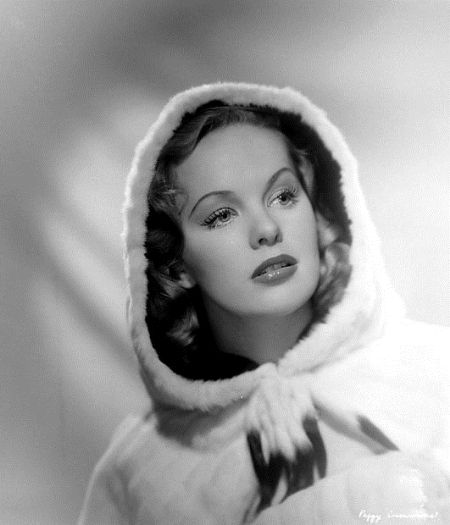
Above: A newly arrived Peggy Cummins building a glamorous image in her early Hollywood years.
While the book was said to raise the spirits of women in wartime, having read it one long ago teenage moment of curiosity, it has since then dawned on me that the book was patched together from Daniel Defoe's Journal of the Plague Year and his The Fortunes and Misfortunes of the Famous Moll Flanders, as well as generous helpings from The Diaries of Samuel Pepys. There's quite a lot of sex, yes, but lots more grime, grit and politics in the streets and the bed chamber, especially since Amber seems to be using what nature gave her to make a niche for herself in a fairly rigid, though often chaotic society. Given the over 700 page book that the screenwriters had to whittle down into a workable movie, it's not surprising that Ms. Cummins, under the rather leaden direction of Otto Preminger, was not able to satisfy Zanuck's wishes. Deciding that she wasn't pretty enough, sexy enough or perhaps malleable enough after about 20 minutes of film had been completed, the mogul placed the lovely but very American Linda Darnell in the coveted part, giving Cummins the boot, and, pretty much ending any chance of her ascendancy in the Hollywood firmament.
Adding insult to injury, the actress was given the demure part of a farm girl in the pleasant The Green Grass of Wyoming (1948), in which she competed with a horse for the affection of Robert Arthur. Another tepid entry in the American phase of her career included one of the great Ronald Colman's lesser vehicles, The Late George Apley (1949), in which Cummins sought to spread her wings a bit as a staid Bostonian's slightly rebellious daughter by marrying someone from Worcester(!).
Too bad Zanuck didn't have the ingenious Joseph Lewis under contract as a director. The imaginative director found unplumbed depths of sex, anger and willful destruction in the angelic looking Peggy when he cast her in the low budget cautionary tale about moral weakness, obsessive relationships and poor impulse control, Gun Crazy(1950). Based on a short story by MacKinlay Kantor, the screenplay was written by Dalton Trumbo using the pseudonym of "Millard Kaufman" while he was on the film industry blacklist. The story focuses on the adventures of a lonely boy Bart (Russ Tamblyn plays him as a lad, with rabbity John Dall as the adult version) whose fixation on gunplay finds a match in Annie Laurie Starr, (Peggy Cummins) the star of a carnival sharp shooting act, who takes aim at his heart and need from the instant that he sees her. Explaining herself a little, the manipulative Annie Laurie assures Bart before they marry that "...I've never been much good--at least up till now I haven't. You aren't getting any bargain, but I've got a funny feeling that I want to be good. I don't know. Maybe I can't. But I'm gonna try. I'll try hard, Bart. I'll try."
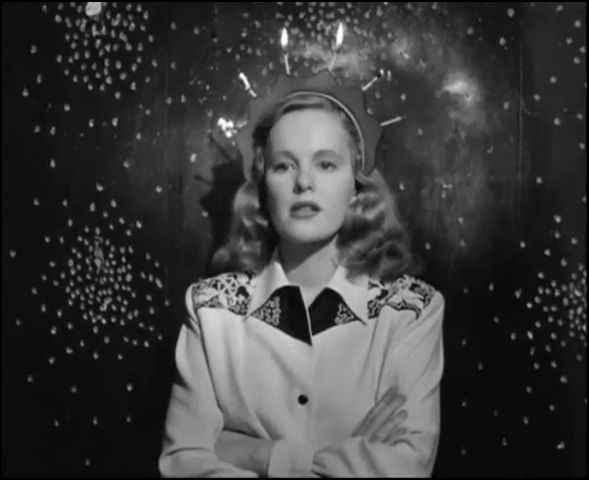
Above: Hark, the angel of death has arrived as played by Peggy Cummins in Gun Crazy (1950).
Long story short, she tries a bit too hard to be good--a good bank robber, that is. Before you can say "Bonnie and Clyde" the pair hurtle across country in a spiral of cinematically innovative crime that leads to Cummins and Dall's inexorable, but very stylish doom. While receiving several critical nods and knocks for the fresh level of violence depicted in the film, after Gun Crazy, the actress returned to the U.K., where she married Derek Dunnett, (while in the U.S., Ms. Cummins is supposed to have dated everyone from Howard Hughes to JFK to Cary Grant), a union that produced two children and lasted until Mr. Dunnett's death in 2001.
On her native soil, some of Cummins memorable movies include Meet Mr. Lucifer (1953) with Stanley Holloway, The Love Lottery with David Niven, Hell Drivers (1957) with Stanley Baker and Patrick McGoohan, and Jacques Tourneur's memorable Curse of the Demon (1957). While always a competent actress, nothing, not even Peggy Cummins last movie, a funny little farce about veterinarians called In the Doghouse (1961), ever came close to matching the power of her searing angel of destruction in Gun Crazy whose character claims that "I've been kicked around all my life, and from now on, I'm gonna start kicking back."
- moira finnie
- Administrator
- Posts: 8024
- Joined: April 9th, 2007, 6:34 pm
- Location: Earth
- Contact:
The Christmas Album: Satchmo
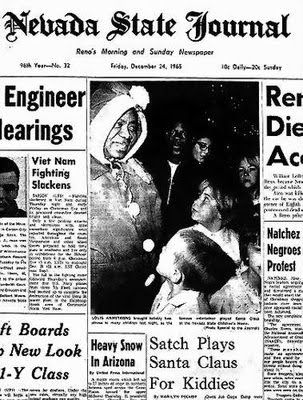
Day Twenty-Four of our Holiday pilgrimage has arrived before we knew it. This photo and story may not have the glam or the humor that we relish at this time of year, but the person who it concerns, Louis Armstrong, had a gift for acknowledging our deepest joys and sorrows through his music, which, as one of the creators of jazz and a vibrant screen presence whenever he appeared in feature films, including Pennies From Heaven (1936), High Society (1956) and Hello, Dolly (1969), made a memorable impact. We begin four decades ago as a little girl who was a resident of the Nevada State Children's Home in 1965 recalled a special day when Mr. Armstrong paid a visit. I do think that you'll be amused by the fact that this is among the few times when a great talent such as Barbra Streisand found herself in the shadow of a very fine man and a great artist. Here is the account of that young lady:
It was Christmas, 1965 at the Nevada State Children’s Home, when the children were greeted by a very special visitor; jazz great Louis Armstrong. Along with Nevada Governor Grant Sawyer and pop vocalist Barbra Streisand, Armstrong had come to play “Santa Claus” for an audience of about 60 children. Little Marthamary had just crawled into Santa Satchmo’s lap to tell him her yuletide requests, when a disturbing episode erupted out of nowhere. Marthamary’s mother, who was also visiting the home, showed up totally inebriated and disheveled singing a tortured version of “I Saw Mommy Kissing Santa Claus.” Marthamary was embarrassed. But this was nothing more than just the latest in a series of abusive incidences that landed the child in the custody of state care.
In Marthamary’s words, many such incidences of maternal embarrassment, mistreatment, and psychological torment had taken place on the grounds of the children’s home, with little, if any, reaction from the staff. She writes, “My mother often took us to the enclosed playground for [the approved visits], surrounding this fenced the playground were three cottages in view. I often saw the counselors and children looking out the windows watching my mother abuse me. No one came to my rescue and no one told the Superintendent, or if they did, they must have thought I deserved it.”
But during Louis Armstrong’s visit to the children’s home that fateful afternoon, the jazz great was the one voice that stood up for a defenseless child that he had never met before.
Satchmo whispered into Marthamary’s ear, “Who is that woman?” And when the child responded that it was her mother, he was indignant. He jumped out and shouted, “Woman who do you think you are coming in here like this? This is a party for children, you children!!! How could you do this to them???” The same energy that Armstrong had brought to the concert stage and the recording studio for over four decades was now being focused on defending a child from continued brutality.
Louis Armstrong could easily identify with Marthamary’s plight because as a young child he too grew up in poverty and had been placed in the New Orleans area “Colored Waif’s Home for Boys.” He understood the hard and tainted reality of growing up in an abusive situation that was complicated by privation and neglect. Thus, he had a fond place in his heart for children, especially those who had been placed into state care. And this concern found its best expression in his care for Marthamary Scherer.
It is here that we see the simple humanity of Louis Armstrong as an organic activist who spoke plainly about the plight of those that society had discarded. Armstrong’s love and concern for the defenseless was borne of a pain and hurt that transcended the barriers of race and forged a unique relationship with the souls of human beings. You see, Louis Armstrong was more than just an innovative musician. He was truly a strong voice that articulated concern for those who could not speak adequately for themselves. And at the heart of this advocacy lies his true greatness.
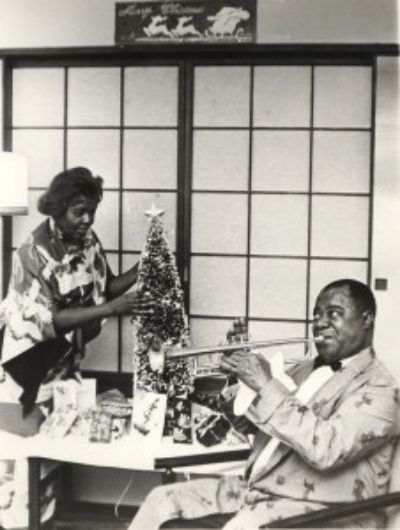
Above: Lucille Armstrong and her husband Louis celebrating the season at home. (Louis Armstrong House)
.
-
klondike
Re: The Christmas Album: Satchmo
And we say to ourselves: "What a Wonderful World" . . because of the strength of humanity in Men like our beloved Mr. Armstrong.moirafinnie wrote:
Louis Armstrong could easily identify with Marthamary’s plight because as a young child he too grew up in poverty and had been placed in the New Orleans area “Colored Waif’s Home for Boys.” He understood the hard and tainted reality of growing up in an abusive situation that was complicated by privation and neglect. Thus, he had a fond place in his heart for children, especially those who had been placed into state care. And this concern found its best expression in his care for Marthamary Scherer.
It is here that we see the simple humanity of Louis Armstrong as an organic activist who spoke plainly about the plight of those that society had discarded. Armstrong’s love and concern for the defenseless was borne of a pain and hurt that transcended the barriers of race and forged a unique relationship with the souls of human beings. You see, Louis Armstrong was more than just an innovative musician. He was truly a strong voice that articulated concern for those who could not speak adequately for themselves. And at the heart of this advocacy lies his true greatness
May the Gods have mercy on the souls of those who put children at risk . . and Bless the hearts of the Heroes who stand up for those children . . 'cause every child is everybody's child!
- moira finnie
- Administrator
- Posts: 8024
- Joined: April 9th, 2007, 6:34 pm
- Location: Earth
- Contact:
The Christmas Album: Peace

Christmas Night has arrived on Day 25 of our holiday sojourn, and for just a moment, the world seems to hold its breath, even in 1944 as night blanketed the world, the lights on Los Angeles streets were lit, the holiday decorations were hung, and a million silent prayers for peace went up. Here's hoping that your wishes for peace are realized today, tonight and in the days to come.
- moira finnie
- Administrator
- Posts: 8024
- Joined: April 9th, 2007, 6:34 pm
- Location: Earth
- Contact:
The Christmas Album: Mary Pickford

For my personal celebration of cinematic Christmases of Hollywood Past this December, 2009, let's kick things off with one of the first ladies of movies, who was--at least in her day--probably the most famous woman in the world.
Barely five feet tall Mary Pickford is seen above posting this sign changing the name of Hollywood Boulevard to Santa Claus Lane in 1928. Mary, beginning in 1925, was the honorary chairman of the Holiday Beautification movement that created the pre-holiday activities of the movie colony. That sign would soon be hung with glass icicles to mimic the real thing. When the Hollywood Christmas Parade began for the first time that year, white corn flakes strewn in the path of the frolicking strolling players would stand in for real snow. Since the temperature in LA rarely hovers near the freezing mark, one wonders how Miss Pickford stood being swaddled in that lovely cloche hat and what looks to be a silver fox trimmed winter coat! Still, such garb, perhaps more revelatory of the veiled aspects of human nature in society rather than an accurate reflection of the true weather, will have to suffice as one of the lovely and mysterious illusions of the movie colony back in the day. For the most part, Mary's possible discomfort with these trappings of public life seem to have been worn with grace for many years.
As with so much of life in Los Angeles in their day, this holiday event was created in part at the instigation of the boundlessly enthusiastic Douglas Fairbanks and his Mary, a married couple (at least since 1920, when both shed their first spouses); they were savvy business people, and titanic creative forces in early cinema as individuals on and off screen. Forming United Artists in 1919 with their friend Charlie Chaplin and the best known director of the day, D.W. Griffith, their company became a model for truly independent producers at that time, prompting one industry wag to mumble something about "the inmates taking over the asylum."
Despite the fact that in her 52 features, she only rarely played a youngster, Pickford's child-like characters, her blonde curls, and small features--along with publicity releases--made a lasting impression on the public, often relegating Mary rather unfairly to jejune roles she had long outgrown creatively and chronologically. A giant in the business behind the camera, the technique of "the girl with the curls" in front of the lens could be both subtle, funny, and indomitable, prompting Photoplay to succinctly describe her appeal as a "luminous tenderness in a steel band of gutter ferocity." Despite this power, Mary could not stop time nor progress. The end of 1928 saw the dawn of talkies, an event that the actress described as a little "like putting lipstick on the Venus de Milo."
Nevertheless, around the same time that she played a cameo as the Virgin Mary (!) in her husband's film The Gaucho (1928), "America's Sweetheart" cut her signature curls in an effort to finally appear closer to her real age of 36, and agreed to appear in her first talkies, Coquette (1928) and The Taming of the Shrew (1929). Sadly, though given their due by an indebted industry (including the first Oscar for "Best Actress" for the former film), such efforts only seem to have made her another earth-bound actress, not the sprite of memory nor the alluring, self-assured woman she might have been if the public hadn't moved on to other distractions by the end of the twenties.
Retiring from a life in the movies by 1934 after supporting her family since childhood, with her marriage to Fairbanks ended and her eventual third and last union with Charles "Buddy" Rogers to come, Pickford lived out her many years ensconced in her Pickfair, the home she'd shared with Doug. Living to 87, and struggling with alcoholism and other issues, she believed that her movies should be destroyed, sensing--erroneously--that an indifferent later generation would not be interested in what she offered on screen.
So, let's take a moment this December to raise a glass to Mary Pickford, (possibly mixing the popular drink of the day seen below, once concocted in speakeasies the world over in her honor): Here's to an actress whose idealized presence in filmdom only showed part of her strengths. Let's remember her wise words on that other parade we call success in this country--"this thing that we call failure: is not the falling down, but the staying down."
The Mary Pickford
1 part light Rum
1 part unsweetened Pineapple juice
¼ tsp Grenadine
¼ tsp Maraschino liqueur
Maraschino cherry
Shake the rum, pineapple juice, grenadine, and maraschino liqueur with ice; then strain into a chilled cocktail glass. Garnish with a maraschino cherry.
- charliechaplinfan
- Posts: 9040
- Joined: January 15th, 2008, 9:49 am
Re: A Christmas Album
Your article on Mary is so eloquent. She was very civic minded, she didn't just occupy the position of first lady of Hollywood, she lived it and tried to improve it. I love the picture you found. I've always admired Mary so much, from reading about her when I was young right through to seeing her movies when they became available on DVD. Seeing her on film was even more powerful, it's not at all that she is a nice memory from a bygone age, to see her on film, she's outstanding, whether playing a girl or a woman, she chose good material, surrounding herself with the best experts of the time and shared a studio with Doug.
Wouldn't it be nice to sample a Christmas in the 1920's. We wouldn't have as much but maybe we'd appreciate the spirit of Christmas more.
Wouldn't it be nice to sample a Christmas in the 1920's. We wouldn't have as much but maybe we'd appreciate the spirit of Christmas more.
Failure is unimportant. It takes courage to make a fool of yourself - Charlie Chaplin
- movieman1957
- Administrator
- Posts: 5522
- Joined: April 15th, 2007, 3:50 pm
- Location: MD
Re: A Christmas Album
Good heavens Moira. I had made a note to myself to pull this thread back up so people might enjoy it again. How lovely we get more stuff.
Chris
"Time flies like an arrow, fruit flies like a banana."
"Time flies like an arrow, fruit flies like a banana."
-
klondike
Re: A Christmas Album
I'm with you, Chris!
Like most SSOers, I took a half an hour (or rather gifted myself 30 minutes) to reacquaint with last year's features that kicked this thread off, and what a perennial delight they turned out to be!
This really served to brighten a dismal day for me!
Like most SSOers, I took a half an hour (or rather gifted myself 30 minutes) to reacquaint with last year's features that kicked this thread off, and what a perennial delight they turned out to be!
This really served to brighten a dismal day for me!
- moira finnie
- Administrator
- Posts: 8024
- Joined: April 9th, 2007, 6:34 pm
- Location: Earth
- Contact:
The Christmas Album: Robert Mitchum

On our second day through Christmas Past, Hollywood-style, what is a bewildered and very youthful Robert Mitchum doing interviewing Santa like a beat reporter in December of 1949? Penance, for one thing.
The pride of RKO, who was apparently the fantasy alter ego of that studio's increasingly squirrelly boss, Howard Hughes, had not had a very good year. At this point, in part to publicize his appearance in a Christmas themed Holiday Affair (1949-Don Hartman), the actor, who had a growing family to feed, found his contract--which had formerly been owned in part by David O. Selznick, to be solely owned by Mr. Hughes. The seemingly imperturbable Mitchum may have struck a nonchalant pose more than once in public during his career, but perhaps he could see some advantages to getting some better press. After his 1948 arrest for his presence in what was described as "a marijuana shack" in Hollywood, the actor might have seen that being colorful could have a downside. Like going to incarceration in a county facility for sixty days of a suspended two year probation sentence. That hard won coolness that he became so well known for helped the actor ride this scandal out, resume his career and continue to support his family. He later claimed that no matter what he did, "There just isn't any pleasing some people. The trick is to stop trying." He may not have appeared to have been breaking a sweat as he churned out product for RKO, but he did put his head down and keep working.
It would be some years after the excellent notices he'd received for his early career peak in The Story of G.I. Joe (1945-Lewis Milestone) were ever repeated. While he would even receive an Oscar nomination as Best Actor in a Supporting Role for his portrayal of an ordinary dogface, Mitchum understood that later films were rarely in the same league as that breakthrough. For every Out of the Past (1947-Jacques Tourneur) there seemed to be a half dozen White Witch Doctor (1953-Henry Hathaway) movies on his C.V. "I often regret my good reviews," he said, "because there is no point in doing something I know to be inferior and then I find I have come off the best in the film. Wouldn't you find that worrying?" Actually, his ability to ingratiate himself with audiences despite some scripts may have been one reason for his longevity. As he later commented wryly, "We kept the same suit for six years - and the same dialog. We just changed the title of the picture and the leading lady."
Eventually, brilliant work in such movies as a madman in Night of the Hunter (1955-Charles Laughton) and as a loving n'er-do-well in The Sundowners (1960-Fred Zinnemann) would earn him far more respect, except perhaps in his own eyes. As he said once about his own profession, "People make too much of acting. You are not helping anyone like being a doctor or even a musician. In the final analysis, you have exalted no one but yourself."
The little movie Robert Mitchum was publicizing in these photos was not a financial success, but in recent years it has been rediscovered as an appealing, low key charmer about a free soul (Mitchum, naturally), a war widow (Janet Leigh, blending pertness, wariness and fresh-faced sexuality) and a straight arrow fiancé (Wendell Corey, in one of his few relaxed characterizations). Their problems may not be earth shaking but some humanity shone through the Hollywood gloss rather nicely. Despite a lifetime of posing as someone who didn't care, at the end of the day, playing a nice guy on screen wasn't such a stretch for the bad boy after all, was it?

- charliechaplinfan
- Posts: 9040
- Joined: January 15th, 2008, 9:49 am
Re: A Christmas Album
I love that movie. I'm quite fond of Robert Mitchum, he was self deprecating, he worked hard and he was a fine actor. Lovely stills Moira.
Failure is unimportant. It takes courage to make a fool of yourself - Charlie Chaplin
